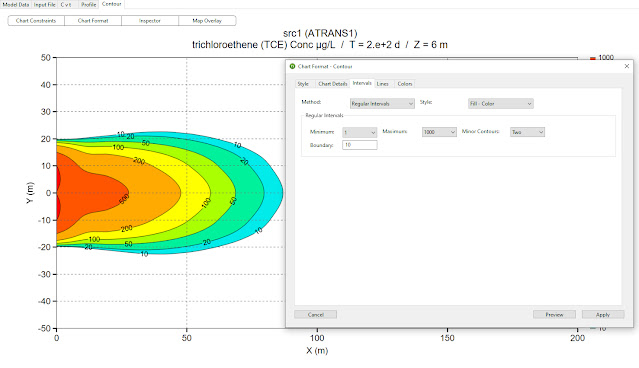Groundwater monitoring wells are often placed in, around, and downgradient from a dissolved contaminant plume for a variety of purposes including:
- Monitoring plume dynamics (concentration changes) in different areas of the plume following a chemical release as the plume grows
- Bounding the plume in the horizontal and vertical for regulatory compliance and remedy planning purposes
- Evaluating plume stability as a criterion for considering a Monitored Natural Attenuation (MNA) remedy
- Projecting plume reduction over time as the result of a source remediation and/or MNA remedy
- Proper placement of downgradient sentinel wells to protect potential receptors
Planning the layout of a
groundwater network is highly source and aquifer specific, with well location
distances and anticipated contaminant arrival times being dependent on
groundwater velocity and source concentration. Placement and interpretation of
concentration patterns are also related to the source type; i.e. whether the
source is constant, slowly declining (flushing), or suddenly removed
(excavation).
Simple analytical contaminant fate
and transport modeling can be very helpful in identifying optimal locations for
monitoring wells, and in interpreting sampling results obtained from those
wells. The following examples illustrate the application of TS-CHEM for the
design and analysis of monitoring well networks for differing source and
aquifer conditions.
Example 1 – Constant Source: Plume
Growth and Stabilization
For the case where a chemical spill creates a continuing constant concentration source to groundwater, a dissolved contaminant plume will form, grow, and eventually stabilize (stop growing) (see time series in Figure 1). Monitoring wells placed down the axis of the plume can show this progression as concentrations rise through time and then sequentially level off at each downgradient location (Fig 2 and Fig 3).
Figure 1. Plume growth and stabilization caused by the slow constant dissolution of a vinyl chloride source. Monitoring wells are located at the following distances from the source: MW-1 400 ft; MW-2 600 ft; MW-3 700 ft; MW-4 875 ft. The placement of MW-4 coincides with the farthest downgradient extent of the plume after it has stabilized about 7.5 years after the initial release.
Figure 2. The spreading plume reaches each downgradient
monitoring well in turn, causing the vinyl chloride concentration at that
location to rise. After some period of time following first impact at a well
location, the plume stabilizes in that area as indicated by the leveling off of
monitoring well concentration.
Figure 3. Zooming in on the lower concentrations measured at
MW-3 and MW-4 shows that these downgradient wells exhibit the same
concentration versus time pattern as the wells in the central area of the
plume.
Example 2 – Instantaneous
Source: Plume Drift and Dissipation
For the case where a small chemical
spill enters groundwater and dissolves - - creating an initial slug source in a
small localized area - - a dissolved contaminant plume will leave that area and
drift downgradient with groundwater seepage, spreading and dissipating as it
does so (see time series in Figure 4). Monitoring wells placed down the axis of
the plume can show this progressive arrival at, passing through, and leaving
each monitoring well area (Fig 5 and Fig 6).
Figure 4. Plume behavior resulting from initial dissolution
of a vinyl chloride source, with subsequent downgradient drift. Monitoring
wells are located at the following distances from the source: MW-1 400 ft; MW-2
600 ft; MW-3 700 ft; MW-4 875 ft. The plume initially expands as it
drifts, but attenuation (dispersion and degradation) gradually reduce the plume
concentrations and plume area, and eventually cause it to disappear.
Figure 5. The drifting and spreading plume reaches each
downgradient monitoring well in turn, causing the vinyl chloride concentration
at that location to rise, peak, and then decline. Notice that the velocity of
the plume peak does not match the groundwater Darcy velocity, nor the retarded
groundwater Darcy velocity.
Figure 6. Zooming in on the lower concentrations measured at
MW-3 and MW-4 shows that these downgradient wells exhibit the same
concentration versus time pattern as the wells in the central area of the
plume.
For the ideal case (often
described in textbooks) the downgradient movement of the plume peak (even as
that peak concentration declines with time) would occur at the same rate as the
calculated Darcy’s Law groundwater pore velocity, which is 146 ft/yr for the
model depicted above. If the chemical of interest were affected by adsorption
and retardation, one might expect the plume peak to move at the rate of the
groundwater velocity divided by the retardation rate. For this vinyl chloride model,
that rate is 146 ft/yr / 1.113 = 131.1 ft/yr.
Instead, the plots above
demonstrate that the plume peak is moves downgradient from the source at a faster
apparent rate of approximately 155 ft/yr - - almost 20 % faster than the
retarded groundwater velocity; and faster even than the average groundwater
linear pore velocity of 146 ft/yr. This is caused by the nonlinear interaction
of all of the processes acting on the vinyl chloride plume: groundwater seepage
velocity, retardation, dispersion, and degradation. Thus, a model can be very
useful in developing a more accurate estimate of the rate of movement of a
detached (from the source) contaminant plume than simple velocity calculations
would provide.
To learn more about TS-CHEM and
how it can be used to assist with the estimation of the extent and movement of
contaminant plumes, or to download a FREE
DEMO of the software, visit the TS-CHEM
Website today!












